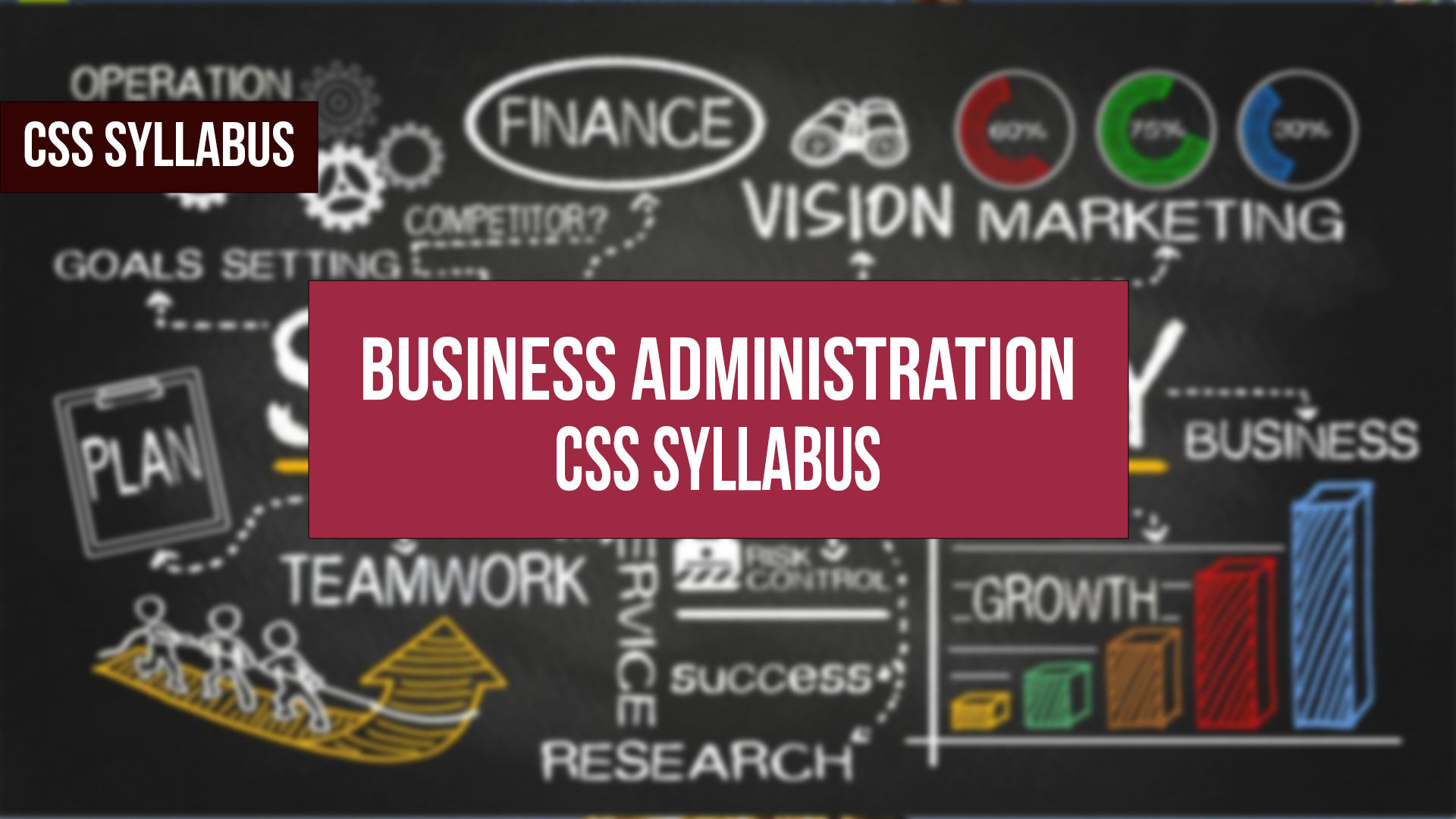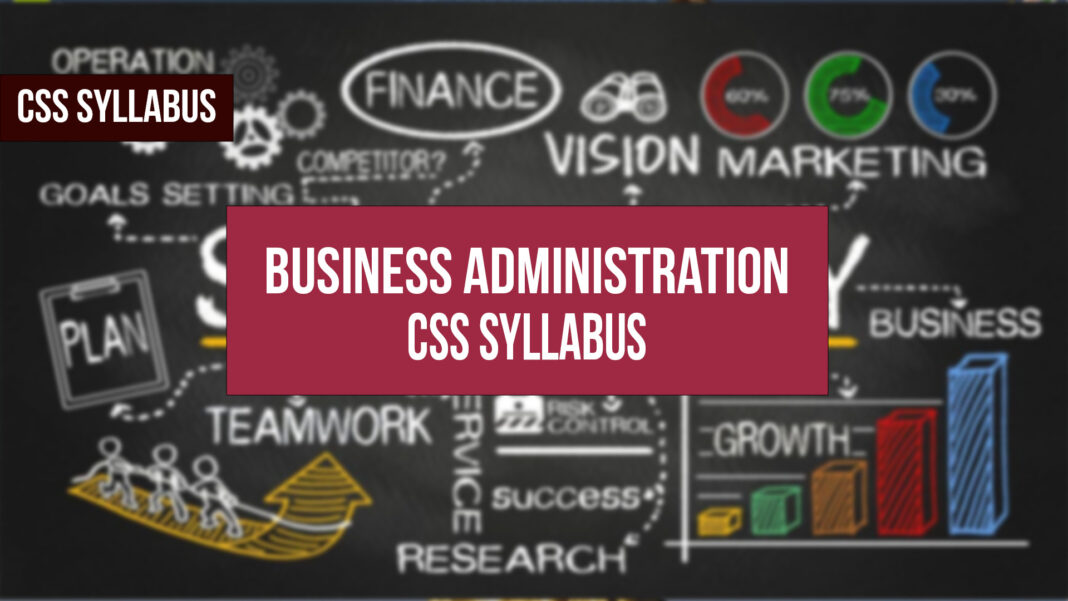Introduction
Embarking on the journey of Business Administration is a pivotal step towards a successful career. In this comprehensive guide, we delve into the intricacies of the revised syllabus and recommended books for Business Administration, ensuring you have the edge in your CSS optional subjects.

Understanding the Revised Syllabus
Core Concepts and Key Changes
The revised syllabus for Business Administration brings forth essential changes that demand a nuanced understanding. From foundational principles to advanced topics, we explore each aspect, providing clarity on what to expect in your CSS exams.
Examining Critical Topics
Strategic Management
Strategic Management stands as a cornerstone in Business Administration. Our guide dissects this subject, offering in-depth insights into strategic planning, implementation, and evaluation. Navigate the complexities of formulating effective business strategies with our expert recommendations.
Financial Management
Unlock the secrets of Financial Management with our recommended books. From financial analysis to budgeting, we break down complex financial concepts into digestible chunks, ensuring you grasp the essentials required for CSS success.
Recommended Books for Business Administration
Curated Reading List
Stay ahead of the curve with our meticulously curated list of recommended books. Each recommendation is handpicked to align with the revised syllabus, providing you with a robust knowledge base for Business Administration.
Business administration CSS Syllabus
Management
Defining Organization, Management, and Management in Organizations
Four Management Functions, Management Roles, Management Skills
Organizational Internal-External Environment
Management Planning, Goal Setting, and Decision Making
Strategic Management Process: Strategy Formulation and Implementation
Developing Organizational Structure and Design
Designing Adaptive Organizations
Managing Change and Innovation
Leadership and Motivation
II. HR Management
Role of Human Resource Management in Organizational Performance
Functions of HRM
Process and Methods of Job Analysis
Planning and Forecasting Personnel Needs
Recruitment and Selection
Training and Development
Performance Management and Appraisal: Methods and Processes
Establishing Strategic Pay Plans
Compensation and Benefits
Ethics, Justice, and Fair Treatment in HR Management
Labor Relations and Collective Bargaining
III. Financial Management
An overview of Financial Management
Introduction and significance of financial markets, Differentiation between real assets
and financial assets, Types of Financial Markets, Role of capital and money markets in
economic development, Organizational goals and shareholder wealth maximization
perspective
Time Value of Money
Cost of money and the factors effecting the cost, Interest rate fundamentals and
determinants of market interest rate, Role of Time value of money in finance, Concept
of future value and present value, Making timelines, Annuities, Perpetuities and mixed
stream of cash flows, with and without growth, Present value and future value of cash
flow streams, Compounding Interest; discrete and continuous, Loan amortization
48
Revised Scheme and Syllabus for CSS Competitive Examination
Analysis and Interpretation of Financial Statements
Reading the financial statements, Horizontal and vertical analysis including common
size, ratio, comparative and index number trend analysis, Forecasting financials for
future decision making, Evaluating credit, management, profitability, risk etc using
financial statements
Risk, Return and Introduction to Pricing
Measures of Risks and return, Investment return and expected rate of return,
Standalone risk: standard deviation and coefficient of variation, Risk aversion and
required rate of return, Portfolio risk: Diversifiable vs. Market risk, Security Market Line
and CAPM, Calculating WACC, Discounting process for price determination, Relevant
risk and return for valuation
Cash flow and Budgeting
Significance of budgeting, Making cash budgets, Making financial forecasts, Difference
between profit and cash flow, Read and analyze Statement of Cash flow.
Capital Budgeting
Significance of Capital budgeting, Cash flow calculations: incremental cash flows,
Capital budgeting decision rules: NPV, IRR, MIRR, Return, Finding optimal capital
structure, calculating appropriate discount rate, Capital Rationing
IV. Operations and Supply Chain Management
a. Operations Management
Operations & Productivity
Operations Management (OM) as one of the Three Core Functions in an
Organization. Significance and contributions of OM in the field of management.
Future trends in OM and differences between goods and services.
Operations Strategy in Global Environment
Developing mission & OM strategies, Critical Success Factors (CSF), Aligning Core
Competencies with CSF
Process Strategy
Four Process Strategies, Process Analysis and Design, Process Mapping, Flow
Diagrams, Process Charts, Service process design, Process Re-engineering
Capacity Planning
Design & Effective Capacity, Capacity Cushion, Capacity considerations, Managing
demand, Capacity Planning, Leading vs Lagging Strategies, Single & Multiple
Product Break Even Analysis for Capacity Planning
Location Strategies
Factors Affecting Location Decisions, Methods for Evaluating Location Alternatives,
Factor Rating Method, Load-Distance Methods, Center of Gravity Method, Service
location Strategy
49
Revised Scheme and Syllabus for CSS Competitive Examination
Layout Strategies
Types of Layout, Layout Design, Fixed Position Layout, Process- Oriented Layouts,
Office Layout, Retail Layout, Assembly Line Balancing
Inventory Management
Role of Inventory in Operations, ABC analysis, Record accuracy, Cycle counting,
Inventory Models, Fixed Period Systems, Continuous Review Systems, Basic EOQ
Inventory Model, Safety Stock, Service Level
b. Supply Chain Management
Introduction to supply chain management and logistics management
What is supply chain management and logistics management, Objectives,
Importance, Examples of supply chain management and logistics management,
Decision phases in supply chains
Supply chain performance
Achieving strategic fit, Challenges in achieving strategic fit, Supply chain cost, Supply
chain quality, Supply chain lead time
Supply chain drivers
Facilities as a driver, Inventory as a driver, Information as a driver, Transportation as
a driver, Sourcing as a driver, Pricing as a driver
Balancing supply and demand
Bullwhip effect, Demand collaboration, Information sharing in supply chains, accurate
response strategy
Supply chain coordination
Obstacles in coordination, Vendor managed inventory, Collaborative planning
forecasting and replenishment, Managerial levers to achieve coordination
IT in supply chain management
Role of IT in supply chain management, Customer relationship management,
Supplier relationship management, Risk management in IT, Supply chain IT in
practice
V. Marketing
Introduction to marketing
Developing marketing strategies and plans
Scanning the marketing environment
Analyzing consumer markets
Market segmentation
Managing marketing information
Branding
Product life cycle
Pricing
Managing distribution channels
Integrated marketing communications
Conclusion
In conclusion, mastering Business Administration requires a strategic approach and access to the right resources. Our guide equips you with the knowledge and recommended readings to not only pass your CSS exams but to excel in the dynamic field of Business Administration. Stay informed, stay ahead.

Editor Timesglo
Editor can be reached at editortimesglo@gmail.com






